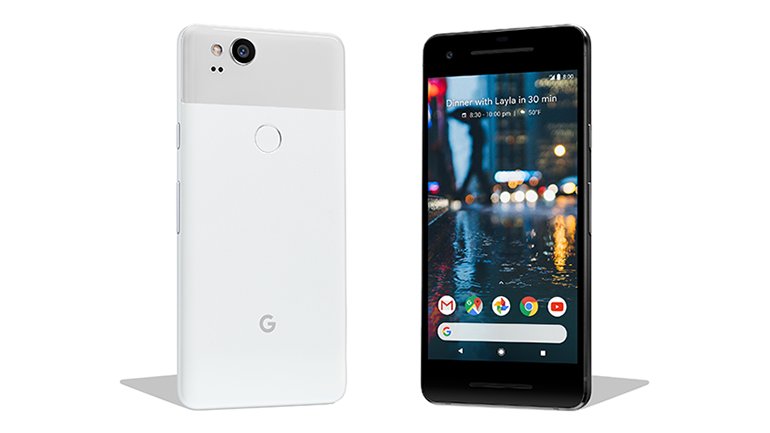After establishing its hardware ambitions with the original Pixel, Google returned in October 2017 with the second generation: the Pixel 2 and Pixel 2 XL. This iteration aimed to refine the successful formula, enhance the camera further, and introduce new hardware conveniences, though it wasn’t without its share of controversies.
Design: Evolution, Not Revolution (Mostly)

The Pixel 2 lineup maintained a family resemblance to the originals but with notable tweaks:
- Refined Body: Still an aluminum unibody, but the distinctive glass “window” on the back was shrunk, covering less area above the repositioned rear fingerprint sensor.
- Water Resistance: A significant upgrade arrived with IP67 water and dust resistance, bringing the Pixels in line with competitors and offering much better protection against splashes and brief submersion than the original’s IP53 rating.
- Front-Facing Stereo Speakers: Both models gained dual front-facing speakers, a welcome addition for media consumption.
- Active Edge: Borrowing tech likely from HTC (who manufactured the smaller Pixel 2, while LG made the larger 2 XL), Google introduced “Active Edge.” Squeezing the lower sides of the phone could instantly launch the Google Assistant or silence incoming calls.
- The Missing Jack: In a move that proved controversial (especially after Google had poked fun at Apple for it the previous year), the Pixel 2 and 2 XL removed the 3.5mm headphone jack. A USB-C to 3.5mm adapter was included in the box, pushing users towards USB-C or Bluetooth audio.
- Colors: The Pixel 2 came in Kinda Blue, Just Black, and Clearly White. The Pixel 2 XL offered Just Black and the iconic Black & White variant, affectionately nicknamed the “Panda” model.
Two Sizes, Two Manufacturers, One Notable Screen Difference
Like the first generation, Google offered two sizes, but with more distinct characteristics:
- Pixel 2 (HTC-made): Featured a 5-inch 16:9 AMOLED display (1920 x 1080), similar in proportion to the original Pixel, resulting in fairly large top and bottom bezels housing the new speakers.
- Pixel 2 XL (LG-made): Moved to a more modern (at the time) 6-inch 18:9 P-OLED display (2880 x 1440) with slimmer bezels, offering a more immersive viewing experience.
While both phones shared the powerful Qualcomm Snapdragon 835 processor and 4GB of RAM (with 64GB or 128GB storage options), the different screen suppliers led to the generation’s main controversy…
The Pixel 2 XL Screen Saga
Early reviews and users of the Pixel 2 XL noted issues with its LG-made P-OLED display that weren’t apparent on the smaller Pixel 2’s Samsung-supplied AMOLED:
- Blue Tint: A noticeable blue color shift when viewing the screen even slightly off-angle.
- Muted Colors: Colors appeared less vibrant or “punchy” compared to competitors and even the smaller Pixel 2. Google initially defended this as prioritizing “natural” color accuracy but later added a “Saturated” color mode via software update.
- Burn-in Concerns: Some early units showed signs of image retention or burn-in relatively quickly. Google addressed this with software updates to subtly shift pixels and dim the navigation bar.
- Graininess/Black Crush: Some users reported a grainy texture or loss of detail in dark areas at low brightness levels.
While Google addressed some issues via software and extended the warranty to two years globally for peace of mind, the screen remained a talking point for the Pixel 2 XL throughout its life.
Camera: Still King, Now Stabilized
Google doubled down on camera excellence:
- Hardware Upgrades: The rear camera used a 12.2MP sensor with a wider f/1.8 aperture and, crucially, added Optical Image Stabilization (OIS) alongside the already excellent Electronic Image Stabilization (EIS) for even better low-light shots and smoother video. It also featured fast Dual-Pixel Autofocus.
- Portrait Mode Magic: Despite having only a single rear lens, Google introduced an outstanding Portrait Mode using the dual-pixel sensor’s depth information combined with machine learning – a stunning software achievement.
- Motion Photos: Google’s answer to Apple’s Live Photos, capturing a short video clip around each still photo.
- Continued Acclaim: The Pixel 2 camera again received top marks, earning a DxOMark score of 98 at launch, briefly regaining the title of best smartphone camera.
- Unlimited Storage: The perk of free, unlimited original-quality Google Photos storage continued.
Software Smarts: Now Playing and Lens
Launching with Android 8.0 Oreo, the Pixel 2 series continued Google’s tradition of clean software and timely updates (receiving support up to Android 11). Key new software features included:
- Now Playing: A fantastic ambient feature that used an on-device database to automatically identify music playing nearby and display the song title and artist on the Always-On Display and lock screen – all without sending audio to Google’s servers.
- Google Lens: Introduced as a preview (initially within Google Photos), Lens allowed users to point their camera at objects, landmarks, text, etc., to get information, translate text, save contact details, and more.
Reception and Legacy
The Pixel 2 and 2 XL were praised for improving on the original’s strengths: the camera remained arguably best-in-class (especially with the addition of Portrait Mode), performance was snappy, the software was intelligent and clean, and the additions of IP67 water resistance and stereo speakers were welcome. Active Edge was seen as a neat, if not essential, feature.
However, the removal of the headphone jack drew criticism, as did the significant bezels on the smaller Pixel 2. The biggest shadow was cast by the Pixel 2 XL’s display issues, which dominated many reviews and discussions. Despite this, the Pixel 2 generation solidified the line’s reputation for camera supremacy and software intelligence, introducing features like software-driven Portrait Mode and Now Playing that showcased Google’s unique strengths.
Let me know what you think! Are you ready to tackle the Pixel 3 next?

Google Pixel 1 was the best pixel!